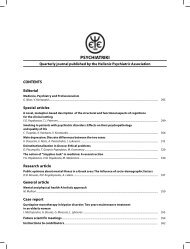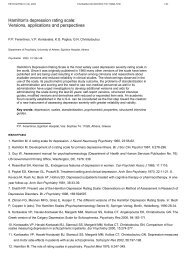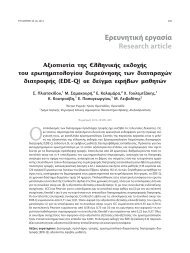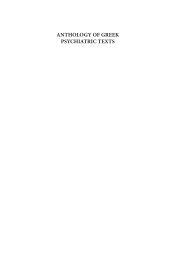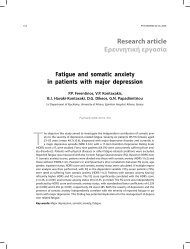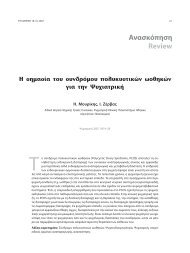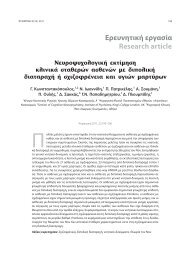Πλήρες Τεύχος - Ελληνική Ψυχιατρική Εταιρεία
Πλήρες Τεύχος - Ελληνική Ψυχιατρική Εταιρεία
Πλήρες Τεύχος - Ελληνική Ψυχιατρική Εταιρεία
Create successful ePaper yourself
Turn your PDF publications into a flip-book with our unique Google optimized e-Paper software.
PSYCHIATRIKI 22 (4), 2011 PSYCHOTROPIC MEDICATION ON IN CHILDREN 317Table 1. Most frequently prescribed psychotropic agentsat the Clinical Department for Children and AdolescentsDrug (%) Dosage (mg) SDAntipsychoticsChlorpromazine 20.9 69.18 28.39Risperidone 56.4 2.44 7.49Haloperidol 7.6 2.08 1.37Levopromazine 4.1 104.69 85.03Olanzapine 1.2 6.25 1.77Clozapine 5.2 188.89 123.82Quetiapine 2.3 38.75 10.31Fluphenazine 2.3 2.75 1.50AntidepressantsSertraline 65.6 70.62 36.64Paroxetine 8.2 20.00 0.00Fluoxetine 23.0 20.00 0.00Escitalopram 1.6 10.00 0.00Mianserin 1.6 30.00 0.00Mood StabilizersCarbamazepine 18.3 327.27 228.43Lamotrigine 21.7 78.85 58.72Sodium valproate 58.3 786.14 533.42Topiramate 1.7 325.00 0.00BenzodiazepinesLorazepam 55.8 3.12 2.51Diazepam 28.8 9.77 5.35Alprazolam 3 68.58 118.140Clonazepam 5 2.40 0.89scribed doses were within the recommended range. 6,7Almost two thirds of antipsychotics belonged to thesecond generation atypical antipsychotics, which isin accordance with trends shown in adult psychiatricpopulation in Serbia. 9 Worldwide trends vary with similarpercentage of atypical antipsychotics prescribed inthe USA. 5Chlorpromazine, a low-potency phenothiazine,makes up for 20.9% of total antipsychotics prescribed.Although nowadays it is considered a second choicemedication for psychotic disorders, chlorpromazinewas used to manage agitation, which justifies its extensiveuse. However, because of its well known anticholinergicand sedative side-effects, and its greater potentialto produce hypotension and lower the seizurethreshold than haloperidol, it ought to be used withcaution. 4,7The second most frequently prescribed class of drugsin our study were SSRIs, shown to have reliable efficacyand a good safety profile when used for treating childrenand adolescents. Clinical studies have confirmedthat fluoxetine has the largest effect size, yet it is thethird most commonly prescribed SSRI in our study.Knowing that all antidepressant drugs have significantrisk when given to children and young people, fluoxetineis the only antidepressant for which clinical trialevidence shows that the benefits outweigh the risks. 15All of the prescribed antidepressants were dosedwithin recommended dose ranges. 6,7 Even though twothirds of used antidepressants were prescribed for officialindications, the single most common diagnosis forwhich they were prescribed was the mixed emotionaland conduct disorder (F92), for which antidepressantsare not officially indicated. Significant acting out frequentlyoccurs among children and adolescents withmajor depression and dysthymic disorder, so there aremany common symptoms in the groups of conductand affective disorders in children and adolescents.Also, the co-existence of major depression with conductdisorder increases the risk of impulsive suicidalbehavior. 14The mood stabilizers were most commonly prescribedfor conduct disorders, and only rarely for bipolardisorder, even though it is the main indicationfor this class of drugs. This discrepancy is due to thefact that conduct disorders make up a larger percentof inpatients. The modes of prescribing mood stabilizerswere in accordance with international guidelines. 6,7However, the most frequently used mood stabilizer, sodiumvalproate, is associated with several serious sideeffects,such as polycystic ovary syndrome, weightgain, as well as CNS toxicity. 4,7Benzodiazepines make up for only 14.4% of prescribedpsychiatric medication for children and adolescents,a conspicuously smaller percentage than theone found in Serbia’s adult psychiatric population. Also,most commonly prescribed drug from this group waslorazepam, whereas for adults it is diazepam. 9The limitation of our study was that our results arenot generalizable. In order to have a more precise pictureof child and adolescent psychopharmacologicaltrends in Serbia it would be necessary to study othermental health centers as well. Beside this, it should bekept in mind that hospitalization is required for seriousand otherwise unmanageable patients, and that, verylikely, this sample doesn’t represent the population ofoutpatients. In the future, follow-up studies are necessaryto assess the change of trends, as well as studies indifferent patient populations and health centers, in or-




